Examining Unprofessional Conduct in Medical Order Documentation
VerifiedAdded on 2023/06/04
|8
|1576
|312
Report
AI Summary
This report examines instances of unprofessional conduct by a nurse related to medical order documentation, highlighting failures in recording postoperative assessments, preoperative checklists, vital signs, pain assessments, and patient assessments. It identifies the impact of these actio...
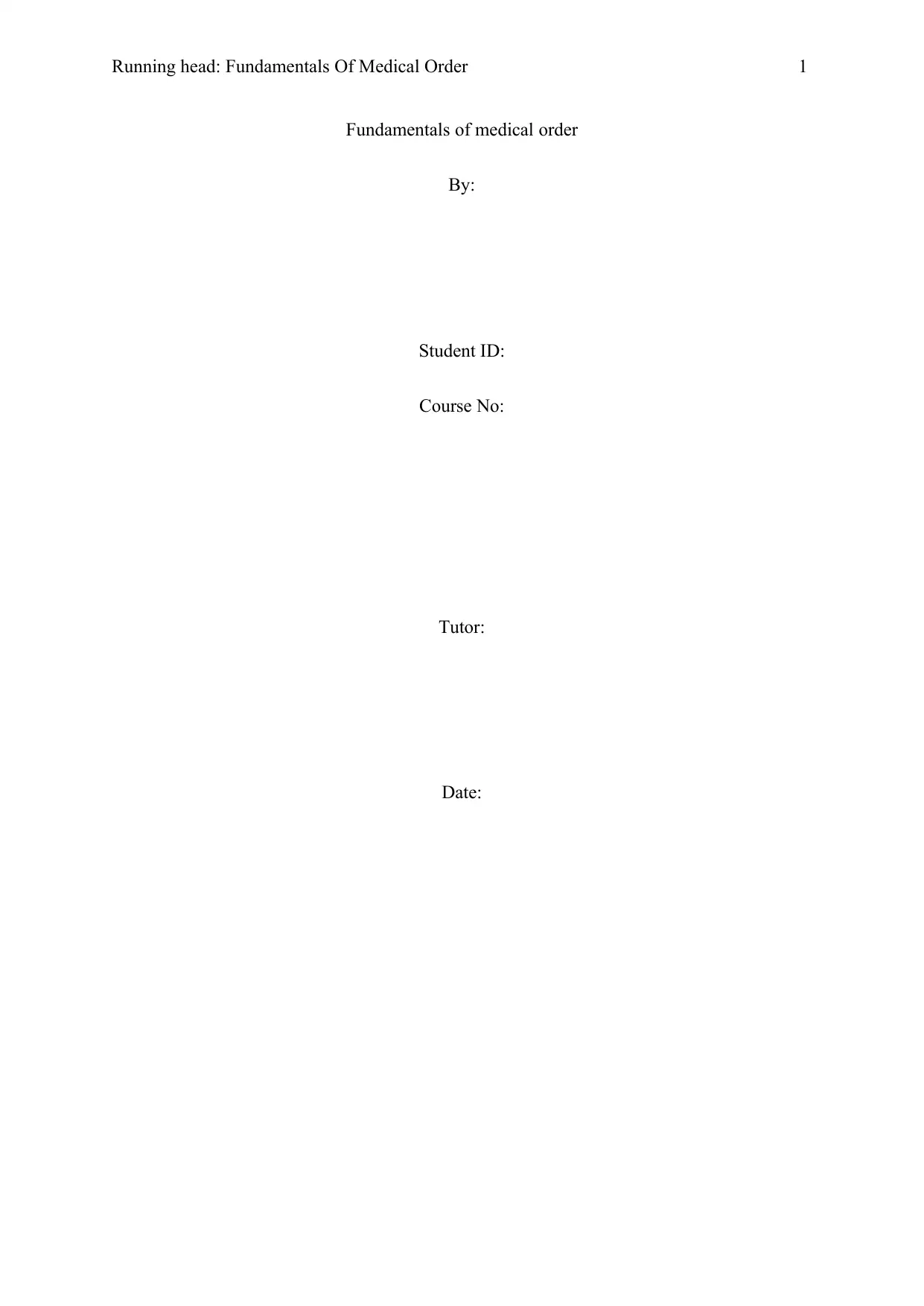
Running head: Fundamentals Of Medical Order 1
Fundamentals of medical order
By:
Student ID:
Course No:
Tutor:
Date:
Fundamentals of medical order
By:
Student ID:
Course No:
Tutor:
Date:
Paraphrase This Document
Need a fresh take? Get an instant paraphrase of this document with our AI Paraphraser
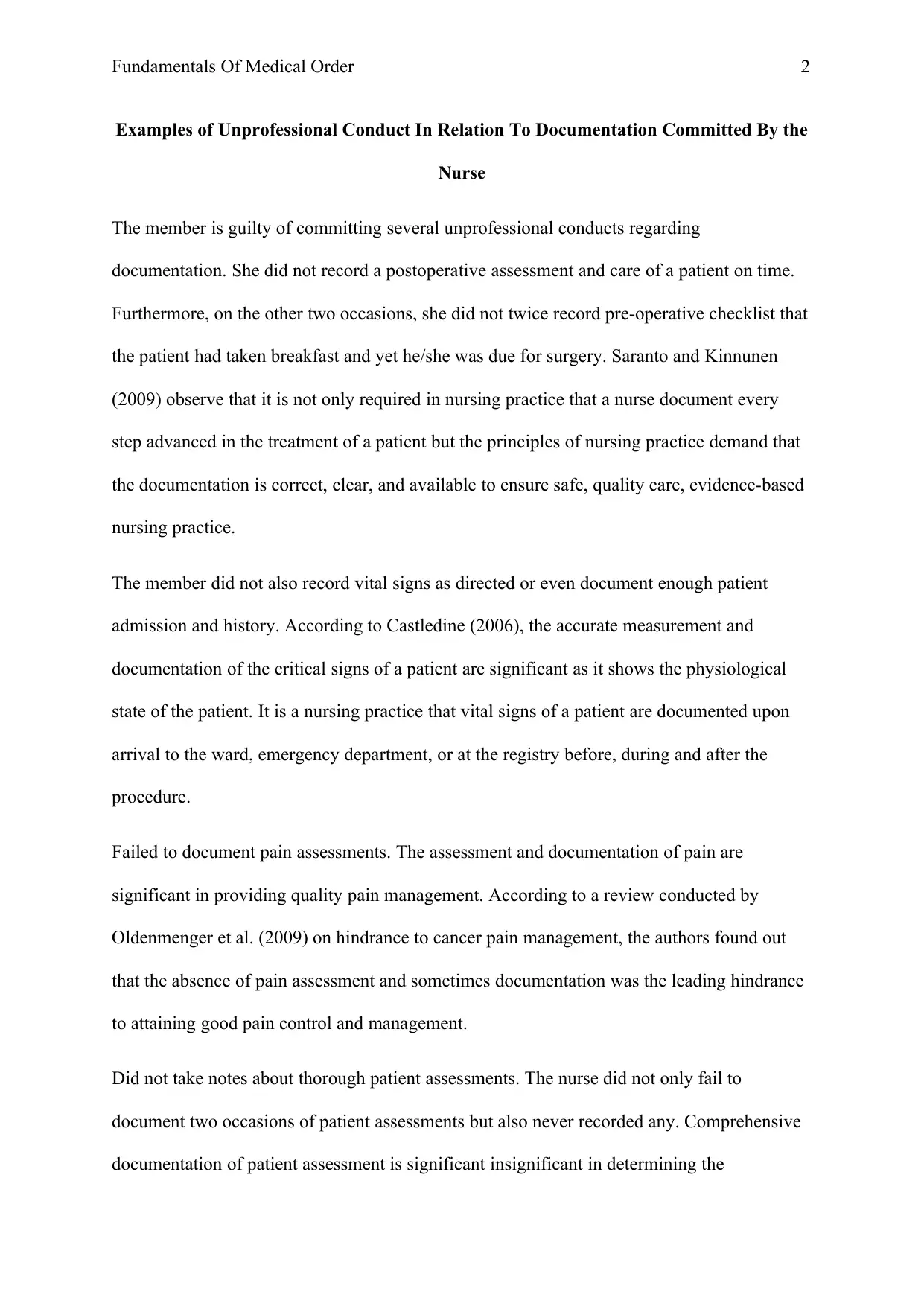
Fundamentals Of Medical Order 2
Examples of Unprofessional Conduct In Relation To Documentation Committed By the
Nurse
The member is guilty of committing several unprofessional conducts regarding
documentation. She did not record a postoperative assessment and care of a patient on time.
Furthermore, on the other two occasions, she did not twice record pre-operative checklist that
the patient had taken breakfast and yet he/she was due for surgery. Saranto and Kinnunen
(2009) observe that it is not only required in nursing practice that a nurse document every
step advanced in the treatment of a patient but the principles of nursing practice demand that
the documentation is correct, clear, and available to ensure safe, quality care, evidence-based
nursing practice.
The member did not also record vital signs as directed or even document enough patient
admission and history. According to Castledine (2006), the accurate measurement and
documentation of the critical signs of a patient are significant as it shows the physiological
state of the patient. It is a nursing practice that vital signs of a patient are documented upon
arrival to the ward, emergency department, or at the registry before, during and after the
procedure.
Failed to document pain assessments. The assessment and documentation of pain are
significant in providing quality pain management. According to a review conducted by
Oldenmenger et al. (2009) on hindrance to cancer pain management, the authors found out
that the absence of pain assessment and sometimes documentation was the leading hindrance
to attaining good pain control and management.
Did not take notes about thorough patient assessments. The nurse did not only fail to
document two occasions of patient assessments but also never recorded any. Comprehensive
documentation of patient assessment is significant insignificant in determining the
Examples of Unprofessional Conduct In Relation To Documentation Committed By the
Nurse
The member is guilty of committing several unprofessional conducts regarding
documentation. She did not record a postoperative assessment and care of a patient on time.
Furthermore, on the other two occasions, she did not twice record pre-operative checklist that
the patient had taken breakfast and yet he/she was due for surgery. Saranto and Kinnunen
(2009) observe that it is not only required in nursing practice that a nurse document every
step advanced in the treatment of a patient but the principles of nursing practice demand that
the documentation is correct, clear, and available to ensure safe, quality care, evidence-based
nursing practice.
The member did not also record vital signs as directed or even document enough patient
admission and history. According to Castledine (2006), the accurate measurement and
documentation of the critical signs of a patient are significant as it shows the physiological
state of the patient. It is a nursing practice that vital signs of a patient are documented upon
arrival to the ward, emergency department, or at the registry before, during and after the
procedure.
Failed to document pain assessments. The assessment and documentation of pain are
significant in providing quality pain management. According to a review conducted by
Oldenmenger et al. (2009) on hindrance to cancer pain management, the authors found out
that the absence of pain assessment and sometimes documentation was the leading hindrance
to attaining good pain control and management.
Did not take notes about thorough patient assessments. The nurse did not only fail to
document two occasions of patient assessments but also never recorded any. Comprehensive
documentation of patient assessment is significant insignificant in determining the
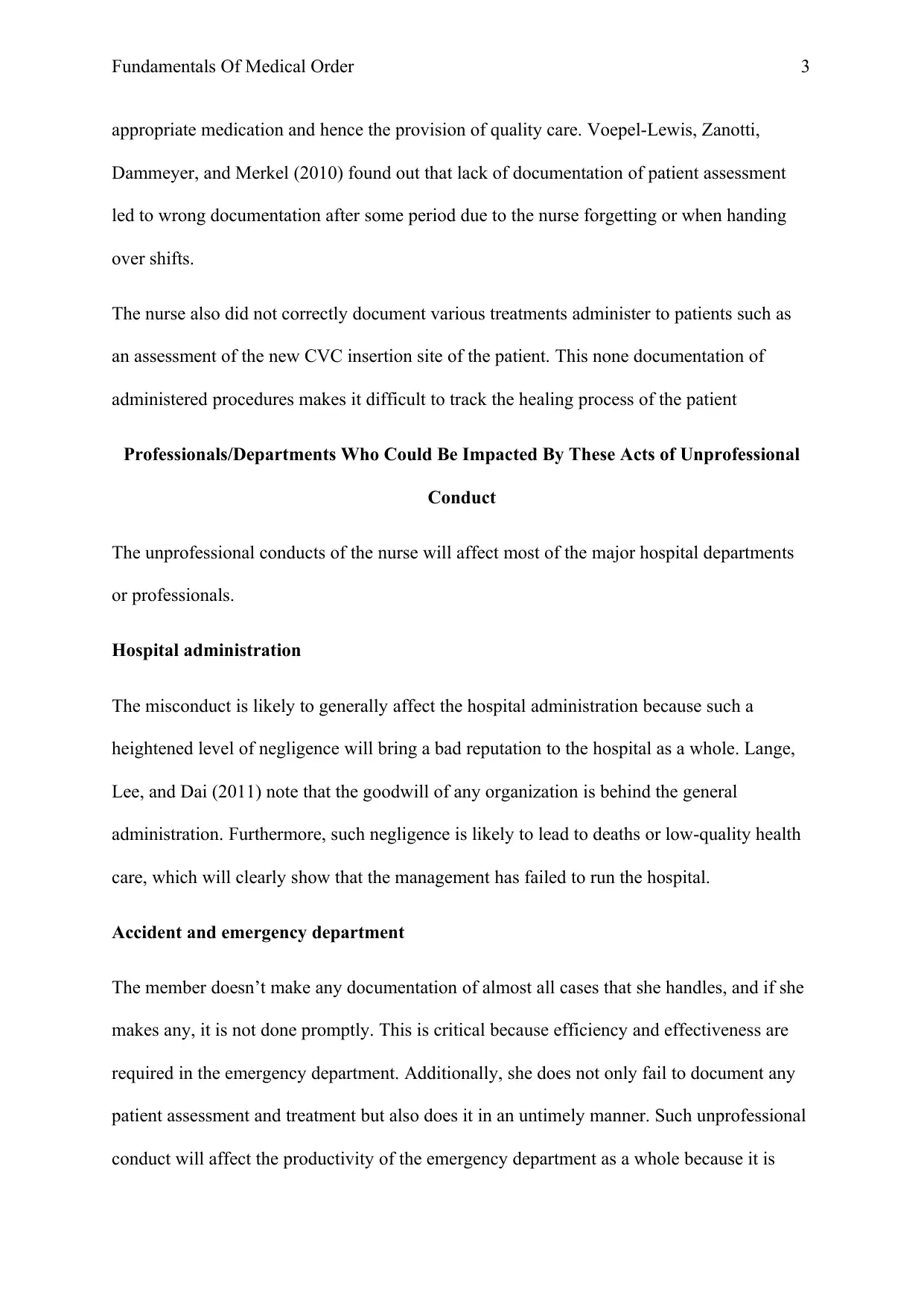
Fundamentals Of Medical Order 3
appropriate medication and hence the provision of quality care. Voepel-Lewis, Zanotti,
Dammeyer, and Merkel (2010) found out that lack of documentation of patient assessment
led to wrong documentation after some period due to the nurse forgetting or when handing
over shifts.
The nurse also did not correctly document various treatments administer to patients such as
an assessment of the new CVC insertion site of the patient. This none documentation of
administered procedures makes it difficult to track the healing process of the patient
Professionals/Departments Who Could Be Impacted By These Acts of Unprofessional
Conduct
The unprofessional conducts of the nurse will affect most of the major hospital departments
or professionals.
Hospital administration
The misconduct is likely to generally affect the hospital administration because such a
heightened level of negligence will bring a bad reputation to the hospital as a whole. Lange,
Lee, and Dai (2011) note that the goodwill of any organization is behind the general
administration. Furthermore, such negligence is likely to lead to deaths or low-quality health
care, which will clearly show that the management has failed to run the hospital.
Accident and emergency department
The member doesn’t make any documentation of almost all cases that she handles, and if she
makes any, it is not done promptly. This is critical because efficiency and effectiveness are
required in the emergency department. Additionally, she does not only fail to document any
patient assessment and treatment but also does it in an untimely manner. Such unprofessional
conduct will affect the productivity of the emergency department as a whole because it is
appropriate medication and hence the provision of quality care. Voepel-Lewis, Zanotti,
Dammeyer, and Merkel (2010) found out that lack of documentation of patient assessment
led to wrong documentation after some period due to the nurse forgetting or when handing
over shifts.
The nurse also did not correctly document various treatments administer to patients such as
an assessment of the new CVC insertion site of the patient. This none documentation of
administered procedures makes it difficult to track the healing process of the patient
Professionals/Departments Who Could Be Impacted By These Acts of Unprofessional
Conduct
The unprofessional conducts of the nurse will affect most of the major hospital departments
or professionals.
Hospital administration
The misconduct is likely to generally affect the hospital administration because such a
heightened level of negligence will bring a bad reputation to the hospital as a whole. Lange,
Lee, and Dai (2011) note that the goodwill of any organization is behind the general
administration. Furthermore, such negligence is likely to lead to deaths or low-quality health
care, which will clearly show that the management has failed to run the hospital.
Accident and emergency department
The member doesn’t make any documentation of almost all cases that she handles, and if she
makes any, it is not done promptly. This is critical because efficiency and effectiveness are
required in the emergency department. Additionally, she does not only fail to document any
patient assessment and treatment but also does it in an untimely manner. Such unprofessional
conduct will affect the productivity of the emergency department as a whole because it is
⊘ This is a preview!⊘
Do you want full access?
Subscribe today to unlock all pages.

Trusted by 1+ million students worldwide
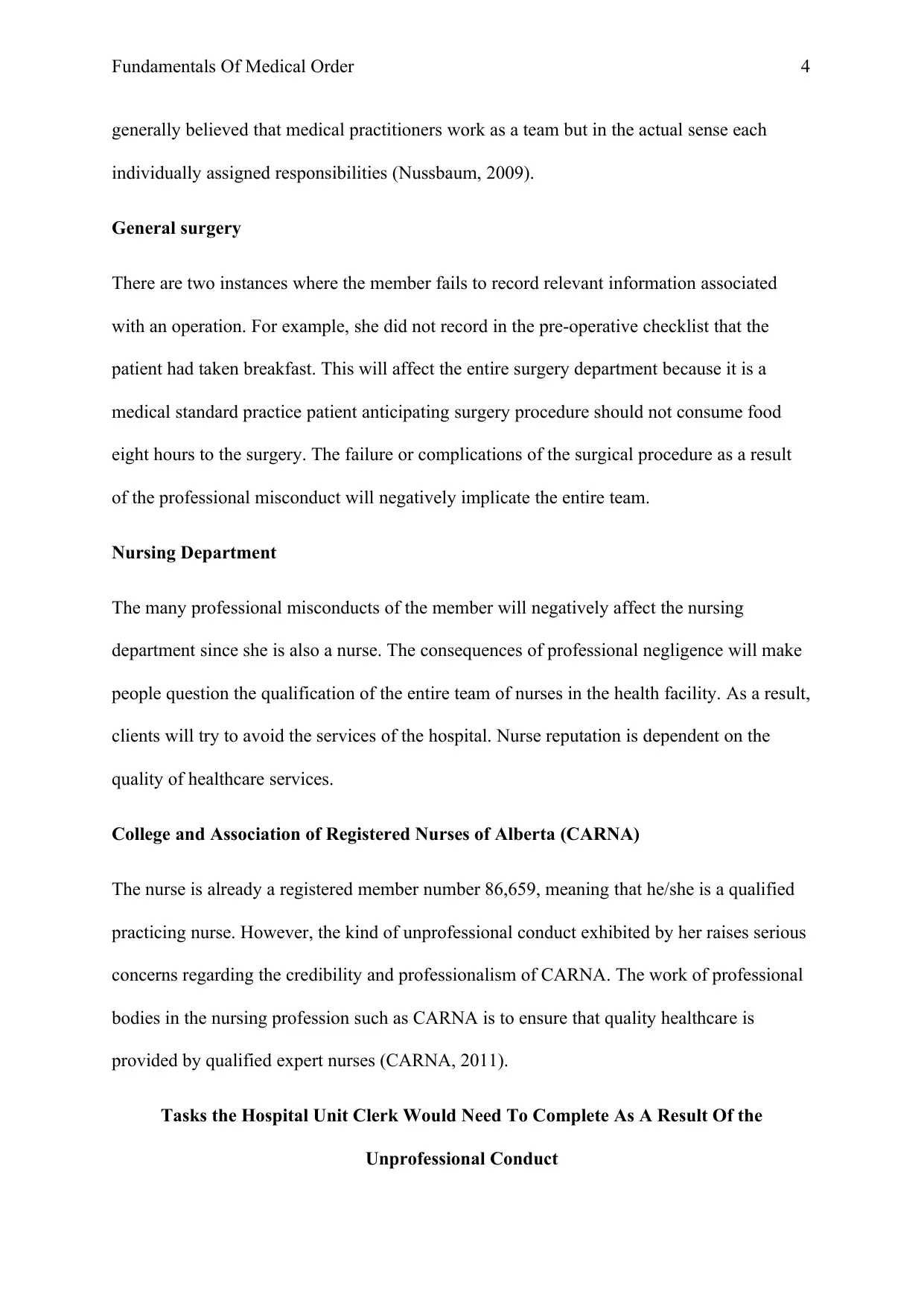
Fundamentals Of Medical Order 4
generally believed that medical practitioners work as a team but in the actual sense each
individually assigned responsibilities (Nussbaum, 2009).
General surgery
There are two instances where the member fails to record relevant information associated
with an operation. For example, she did not record in the pre-operative checklist that the
patient had taken breakfast. This will affect the entire surgery department because it is a
medical standard practice patient anticipating surgery procedure should not consume food
eight hours to the surgery. The failure or complications of the surgical procedure as a result
of the professional misconduct will negatively implicate the entire team.
Nursing Department
The many professional misconducts of the member will negatively affect the nursing
department since she is also a nurse. The consequences of professional negligence will make
people question the qualification of the entire team of nurses in the health facility. As a result,
clients will try to avoid the services of the hospital. Nurse reputation is dependent on the
quality of healthcare services.
College and Association of Registered Nurses of Alberta (CARNA)
The nurse is already a registered member number 86,659, meaning that he/she is a qualified
practicing nurse. However, the kind of unprofessional conduct exhibited by her raises serious
concerns regarding the credibility and professionalism of CARNA. The work of professional
bodies in the nursing profession such as CARNA is to ensure that quality healthcare is
provided by qualified expert nurses (CARNA, 2011).
Tasks the Hospital Unit Clerk Would Need To Complete As A Result Of the
Unprofessional Conduct
generally believed that medical practitioners work as a team but in the actual sense each
individually assigned responsibilities (Nussbaum, 2009).
General surgery
There are two instances where the member fails to record relevant information associated
with an operation. For example, she did not record in the pre-operative checklist that the
patient had taken breakfast. This will affect the entire surgery department because it is a
medical standard practice patient anticipating surgery procedure should not consume food
eight hours to the surgery. The failure or complications of the surgical procedure as a result
of the professional misconduct will negatively implicate the entire team.
Nursing Department
The many professional misconducts of the member will negatively affect the nursing
department since she is also a nurse. The consequences of professional negligence will make
people question the qualification of the entire team of nurses in the health facility. As a result,
clients will try to avoid the services of the hospital. Nurse reputation is dependent on the
quality of healthcare services.
College and Association of Registered Nurses of Alberta (CARNA)
The nurse is already a registered member number 86,659, meaning that he/she is a qualified
practicing nurse. However, the kind of unprofessional conduct exhibited by her raises serious
concerns regarding the credibility and professionalism of CARNA. The work of professional
bodies in the nursing profession such as CARNA is to ensure that quality healthcare is
provided by qualified expert nurses (CARNA, 2011).
Tasks the Hospital Unit Clerk Would Need To Complete As A Result Of the
Unprofessional Conduct
Paraphrase This Document
Need a fresh take? Get an instant paraphrase of this document with our AI Paraphraser
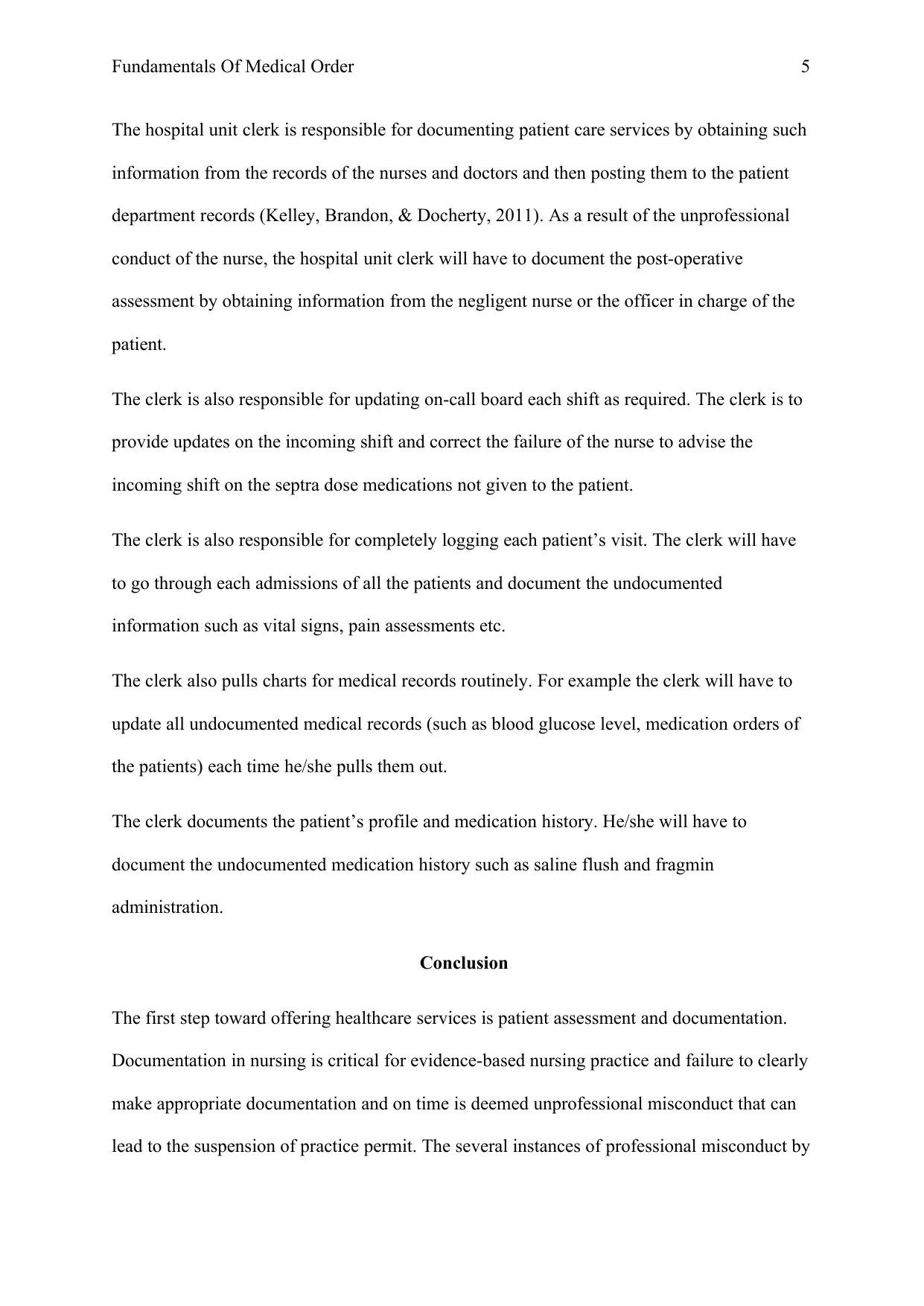
Fundamentals Of Medical Order 5
The hospital unit clerk is responsible for documenting patient care services by obtaining such
information from the records of the nurses and doctors and then posting them to the patient
department records (Kelley, Brandon, & Docherty, 2011). As a result of the unprofessional
conduct of the nurse, the hospital unit clerk will have to document the post-operative
assessment by obtaining information from the negligent nurse or the officer in charge of the
patient.
The clerk is also responsible for updating on-call board each shift as required. The clerk is to
provide updates on the incoming shift and correct the failure of the nurse to advise the
incoming shift on the septra dose medications not given to the patient.
The clerk is also responsible for completely logging each patient’s visit. The clerk will have
to go through each admissions of all the patients and document the undocumented
information such as vital signs, pain assessments etc.
The clerk also pulls charts for medical records routinely. For example the clerk will have to
update all undocumented medical records (such as blood glucose level, medication orders of
the patients) each time he/she pulls them out.
The clerk documents the patient’s profile and medication history. He/she will have to
document the undocumented medication history such as saline flush and fragmin
administration.
Conclusion
The first step toward offering healthcare services is patient assessment and documentation.
Documentation in nursing is critical for evidence-based nursing practice and failure to clearly
make appropriate documentation and on time is deemed unprofessional misconduct that can
lead to the suspension of practice permit. The several instances of professional misconduct by
The hospital unit clerk is responsible for documenting patient care services by obtaining such
information from the records of the nurses and doctors and then posting them to the patient
department records (Kelley, Brandon, & Docherty, 2011). As a result of the unprofessional
conduct of the nurse, the hospital unit clerk will have to document the post-operative
assessment by obtaining information from the negligent nurse or the officer in charge of the
patient.
The clerk is also responsible for updating on-call board each shift as required. The clerk is to
provide updates on the incoming shift and correct the failure of the nurse to advise the
incoming shift on the septra dose medications not given to the patient.
The clerk is also responsible for completely logging each patient’s visit. The clerk will have
to go through each admissions of all the patients and document the undocumented
information such as vital signs, pain assessments etc.
The clerk also pulls charts for medical records routinely. For example the clerk will have to
update all undocumented medical records (such as blood glucose level, medication orders of
the patients) each time he/she pulls them out.
The clerk documents the patient’s profile and medication history. He/she will have to
document the undocumented medication history such as saline flush and fragmin
administration.
Conclusion
The first step toward offering healthcare services is patient assessment and documentation.
Documentation in nursing is critical for evidence-based nursing practice and failure to clearly
make appropriate documentation and on time is deemed unprofessional misconduct that can
lead to the suspension of practice permit. The several instances of professional misconduct by
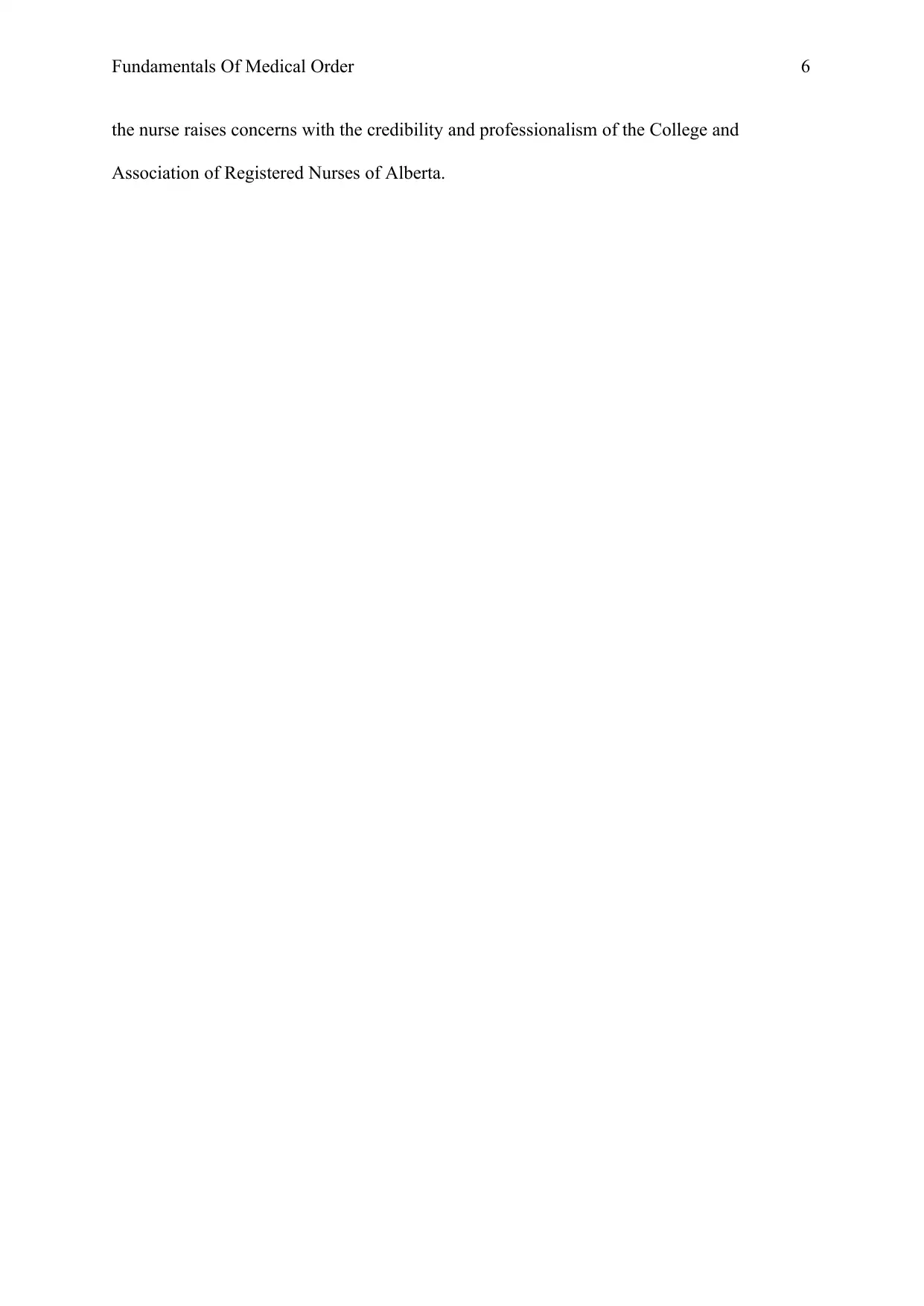
Fundamentals Of Medical Order 6
the nurse raises concerns with the credibility and professionalism of the College and
Association of Registered Nurses of Alberta.
the nurse raises concerns with the credibility and professionalism of the College and
Association of Registered Nurses of Alberta.
⊘ This is a preview!⊘
Do you want full access?
Subscribe today to unlock all pages.

Trusted by 1+ million students worldwide
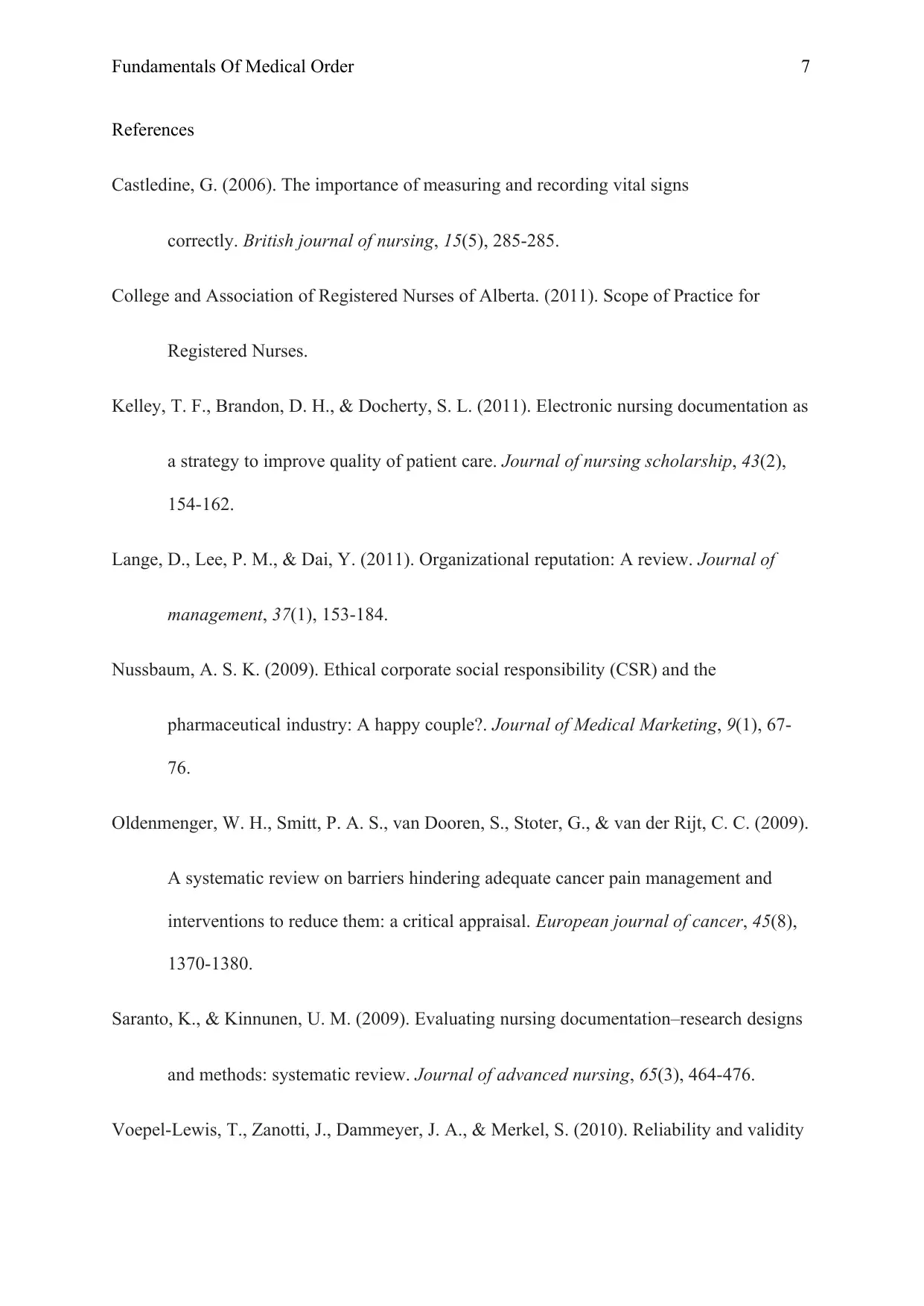
Fundamentals Of Medical Order 7
References
Castledine, G. (2006). The importance of measuring and recording vital signs
correctly. British journal of nursing, 15(5), 285-285.
College and Association of Registered Nurses of Alberta. (2011). Scope of Practice for
Registered Nurses.
Kelley, T. F., Brandon, D. H., & Docherty, S. L. (2011). Electronic nursing documentation as
a strategy to improve quality of patient care. Journal of nursing scholarship, 43(2),
154-162.
Lange, D., Lee, P. M., & Dai, Y. (2011). Organizational reputation: A review. Journal of
management, 37(1), 153-184.
Nussbaum, A. S. K. (2009). Ethical corporate social responsibility (CSR) and the
pharmaceutical industry: A happy couple?. Journal of Medical Marketing, 9(1), 67-
76.
Oldenmenger, W. H., Smitt, P. A. S., van Dooren, S., Stoter, G., & van der Rijt, C. C. (2009).
A systematic review on barriers hindering adequate cancer pain management and
interventions to reduce them: a critical appraisal. European journal of cancer, 45(8),
1370-1380.
Saranto, K., & Kinnunen, U. M. (2009). Evaluating nursing documentation–research designs
and methods: systematic review. Journal of advanced nursing, 65(3), 464-476.
Voepel-Lewis, T., Zanotti, J., Dammeyer, J. A., & Merkel, S. (2010). Reliability and validity
References
Castledine, G. (2006). The importance of measuring and recording vital signs
correctly. British journal of nursing, 15(5), 285-285.
College and Association of Registered Nurses of Alberta. (2011). Scope of Practice for
Registered Nurses.
Kelley, T. F., Brandon, D. H., & Docherty, S. L. (2011). Electronic nursing documentation as
a strategy to improve quality of patient care. Journal of nursing scholarship, 43(2),
154-162.
Lange, D., Lee, P. M., & Dai, Y. (2011). Organizational reputation: A review. Journal of
management, 37(1), 153-184.
Nussbaum, A. S. K. (2009). Ethical corporate social responsibility (CSR) and the
pharmaceutical industry: A happy couple?. Journal of Medical Marketing, 9(1), 67-
76.
Oldenmenger, W. H., Smitt, P. A. S., van Dooren, S., Stoter, G., & van der Rijt, C. C. (2009).
A systematic review on barriers hindering adequate cancer pain management and
interventions to reduce them: a critical appraisal. European journal of cancer, 45(8),
1370-1380.
Saranto, K., & Kinnunen, U. M. (2009). Evaluating nursing documentation–research designs
and methods: systematic review. Journal of advanced nursing, 65(3), 464-476.
Voepel-Lewis, T., Zanotti, J., Dammeyer, J. A., & Merkel, S. (2010). Reliability and validity
Paraphrase This Document
Need a fresh take? Get an instant paraphrase of this document with our AI Paraphraser
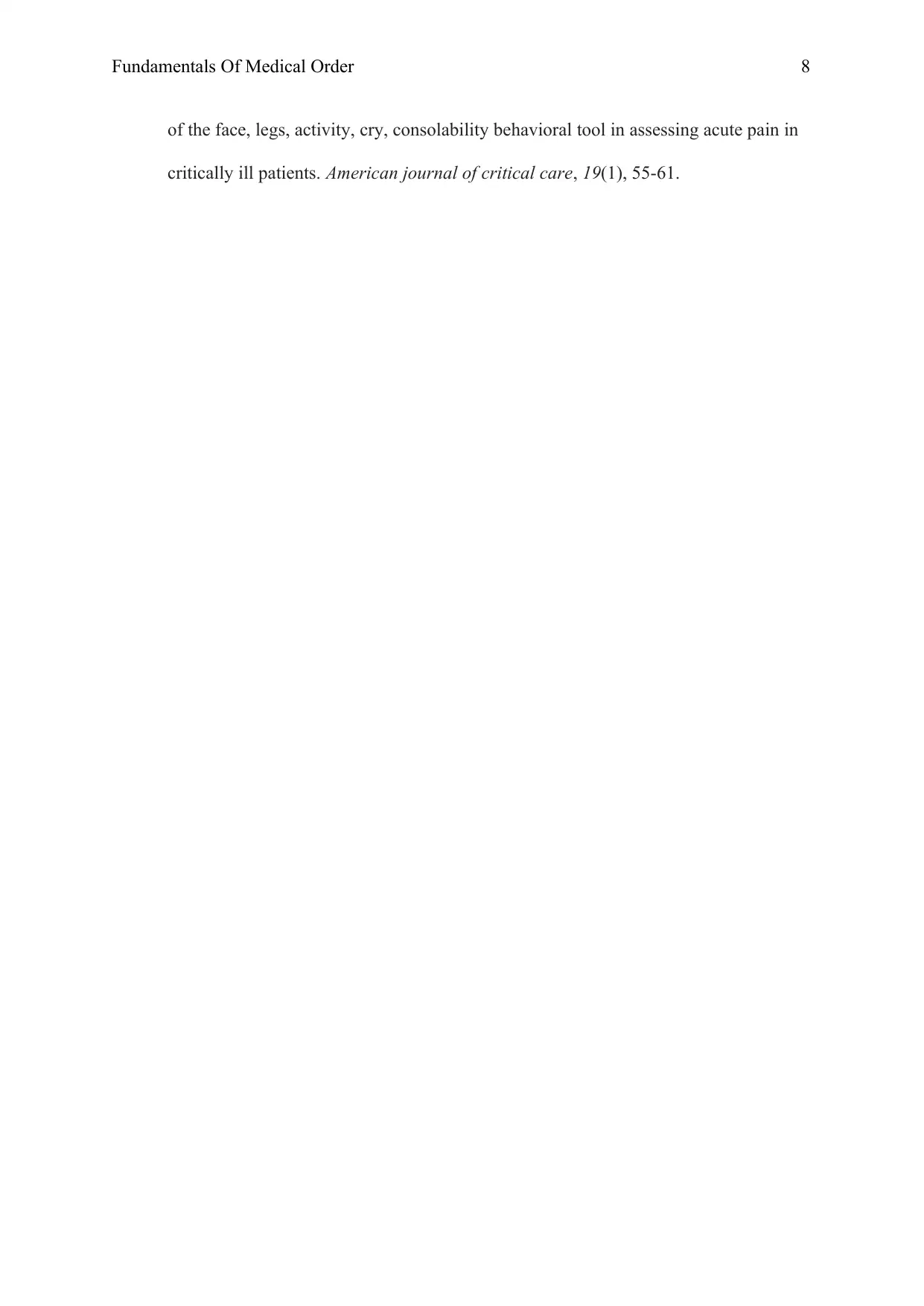
Fundamentals Of Medical Order 8
of the face, legs, activity, cry, consolability behavioral tool in assessing acute pain in
critically ill patients. American journal of critical care, 19(1), 55-61.
of the face, legs, activity, cry, consolability behavioral tool in assessing acute pain in
critically ill patients. American journal of critical care, 19(1), 55-61.
1 out of 8
Related Documents
Your All-in-One AI-Powered Toolkit for Academic Success.
+13062052269
info@desklib.com
Available 24*7 on WhatsApp / Email
![[object Object]](/_next/static/media/star-bottom.7253800d.svg)
Unlock your academic potential
© 2024 | Zucol Services PVT LTD | All rights reserved.





